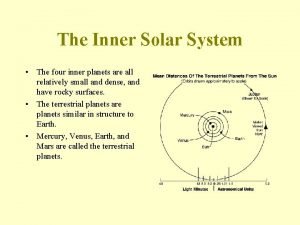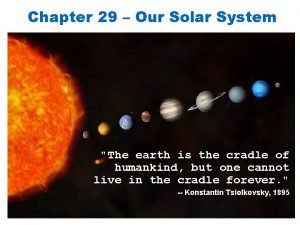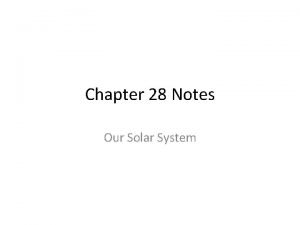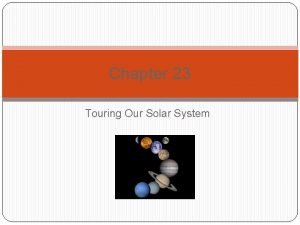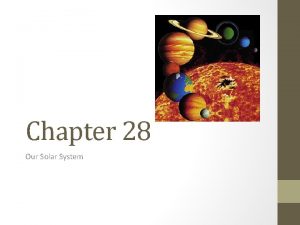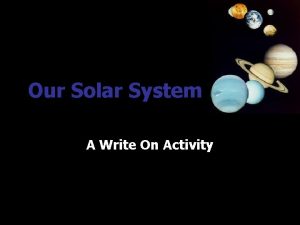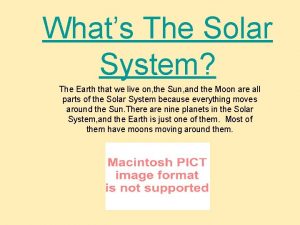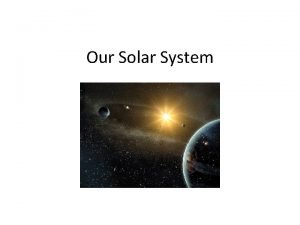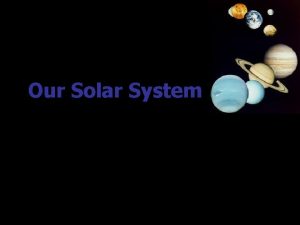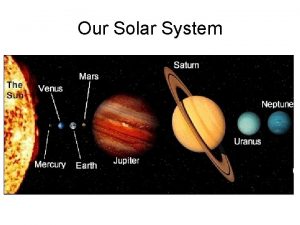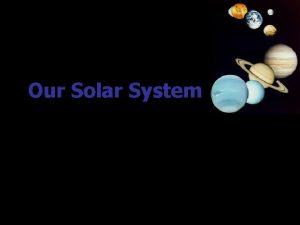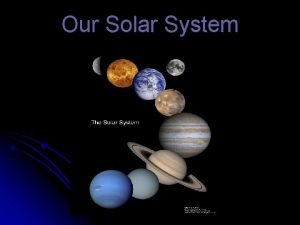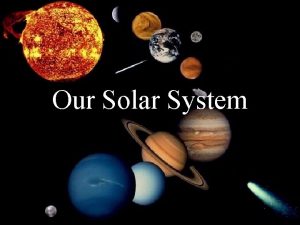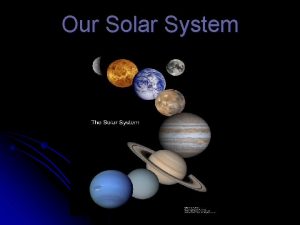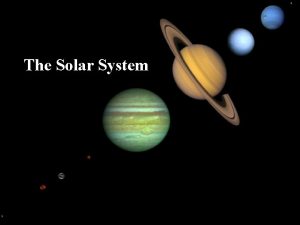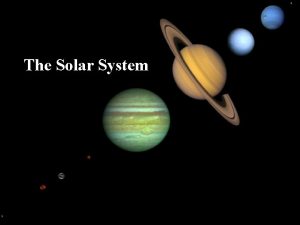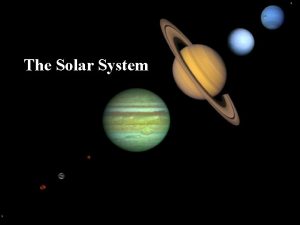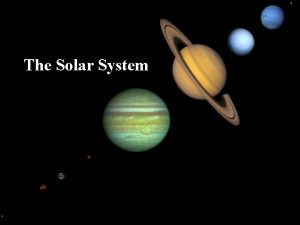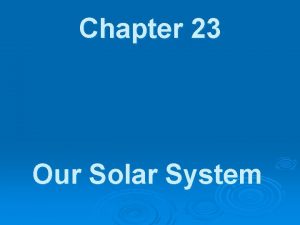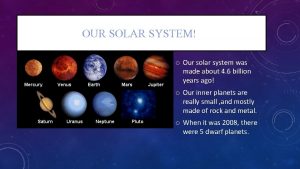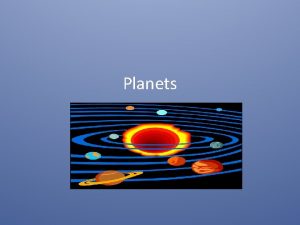The Solar System Whats in Our Solar System



















- Slides: 19

The Solar System

What’s in Our Solar System? • Our Solar System consists of a central star (the Sun), the eight planets orbiting the sun, moons, asteroids, comets, meteors, interplanetary gas, dust, and all the “space” in between them. • The eight planets of the Solar System are named for Greek and Roman Gods and Goddesses.

Inner and Outer Planets • Inner Planets: – Mercury – Venus – Earth – Mars • Outer Planets – Jupiter – Saturn – Uranus – Neptune – Pluto (no longer considered to be a planet)


The Relative Size of the Planets in the Solar System

The Sun • The sun’s energy comes from nuclear fusion (where hydrogen is converted to helium) within its core. This energy is released from the sun in the form of heat and light. • Remember: Stars produce light. Planets reflect light. • A star’s temperature determines its “color. ” The coldest stars are red. The hottest stars are blue.

The 8 Planets of the Solar System • Planets are categorized according to composition and size. There are two main categories of planets: – small rocky planets (Mercury, Venus, Earth, Mars, and Pluto) – gas giants (Jupiter, Saturn, Uranus, and Neptune)

Characteristics of Small Rocky Planets • • • They are made up mostly of rock and metal. They are very heavy. They move slowly in space. They have no rings and few moons (if any). They have a diameter of less than 13, 000 km.

Mercury • One side is always burning hot and the other side is freezing cold. • Mercury has a revolution period of 88 days. Mercury has extreme temperature fluctuations, ranging from 800 F (daytime) to -270 F (nighttime). • Even though it is the closest planet to the sun, Scientists believe there is ICE on

Venus • Venus is the brightest object in the sky after the sun and moon because its atmosphere reflects sunlight so well. People often mistake it for a star. • Venus is known as “Earth’s Twin” because they are almost the same size. • Its maximum surface temperature may reach 900 F. • Venus has no moons and takes 225 days to complete an orbit.

Earth • Earth is the only planet known to support life. • Earth’s surface is composed of 71% water. – Water is necessary for life on Earth. – The oceans help maintain Earth’s stable temperatures. • Earth has one moon and an oxygen rich atmosphere.

Earth’s Moon • It takes the moon approximately 29 days to complete one rotation. The same side of the moon always faces us. • The moon’s surface is covered in dust and rocky debris from meteor impacts. It has no water or atmosphere. • The moon reflects light from the sun onto the earth’s surface.

Mars • Like Earth, Mars has ice caps at its poles. • Mars has the largest volcano in our solar system called Olympus Mons. • Mars appears red because of iron oxide, or rust, in its soil. • Mars is called the “Red Planet” because of its color • Mars has two moons and takes about two years to complete an orbit.

Pluto • Pluto has only one moon and takes about 249 years to orbit the sun. • Part of Pluto’s orbit passes inside that of Neptune, so at times Neptune is the planet farthest from the sun. • Pluto was located and named in 1930, but today Pluto is no longer considered a planet.

Characteristics of Gas Giants • They are made up mostly of gases (primarily hydrogen & helium). • They are very light for their size. • They move quickly in space. • They have rings and many moons. • They have a diameter of less than 48, 000 km

Jupiter • Jupiter is the largest “Gas Giant” planet. • It’s diameter is 11 times bigger than that of the Earth’s. • It takes about 12 years for Jupiter to orbit the sun. • Jupiter has 16 known moons.

Saturn • Saturn is composed almost entirely of hydrogen and helium. • Saturn has many rings made of ice. Saturn’s rings are very wide. • Saturn in known for its visible rings. • Saturn has 18 known moons, some of which orbit inside the rings! • It takes Saturn about 30 years to orbit the sun.

Uranus • Uranus is blue in color due to methane gas in its atmosphere. • Uranus is the only planet that spins on its side. • Uranus has 11 dark rings surrounding it. • Uranus has 21 known moons and takes 84 years to complete one

Neptune • Neptune has the fastest winds in the solar system: up to 2, 000 km/hr. • Neptune is also blue in color due to methane gas in its atmosphere. • Neptune is the furthest planet from the sun and has a “Great Dark Spot. ” • Neptune takes 165 years to orbit the sun and has 8 moons.
 The four inner planets of our solar system are
The four inner planets of our solar system are Chapter 29 our solar system
Chapter 29 our solar system Chapter 28 our solar system
Chapter 28 our solar system Chapter 23 touring our solar system
Chapter 23 touring our solar system Chapter 28 our solar system
Chapter 28 our solar system What are the inner planets
What are the inner planets Biggest planet in our solar system
Biggest planet in our solar system Write about our solar system
Write about our solar system Whats the biggest planet in the solar system
Whats the biggest planet in the solar system Thinking affects our language, which then affects our:
Thinking affects our language, which then affects our: Our census our future
Our census our future Christ be our light shine in our hearts
Christ be our light shine in our hearts Marcus aurelius our life is what our thoughts make it
Marcus aurelius our life is what our thoughts make it We bow our hearts we bend our knees
We bow our hearts we bend our knees Our census our future
Our census our future Our life is what our thoughts make it
Our life is what our thoughts make it Money madness summary in english
Money madness summary in english Awareness of ourselves and our environment is
Awareness of ourselves and our environment is Awareness of ourselves and our environment is
Awareness of ourselves and our environment is God our father christ our brother
God our father christ our brother
